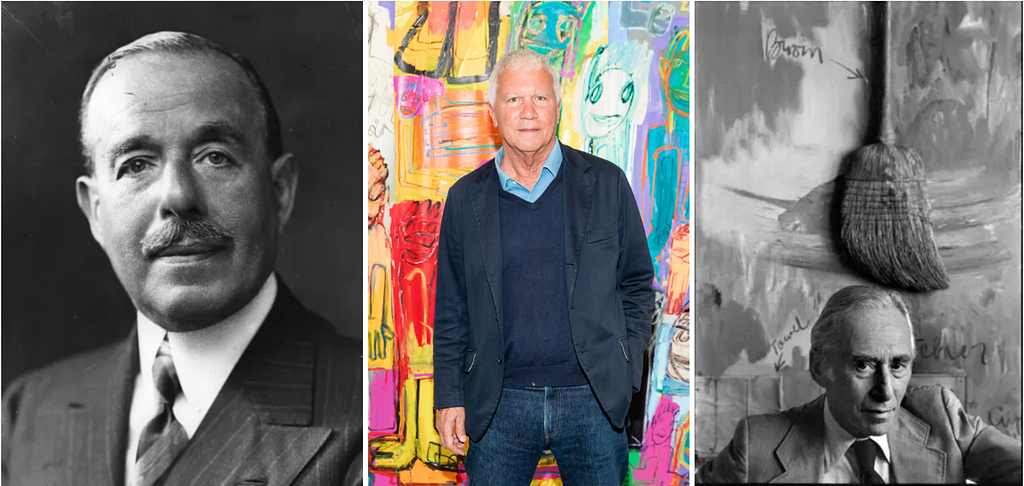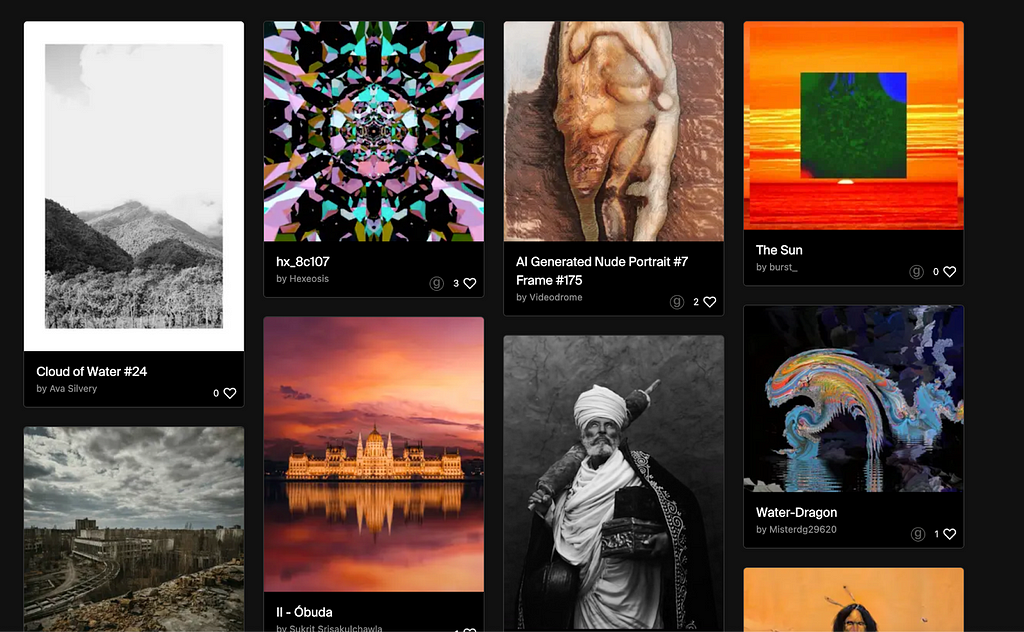How to Snuff Them Out, How to Stand in Their Way
A Teaser for an Essay About Crypto Art Collectors
This is a teaser for the third of a series of four essays written on crypto art collectorship through the Summer and Fall of 2023. These essays were based on 18 interviews conducted in April and May 2023. While not every collector interviewed appears in every essay, their collective insight heavily influenced the direction and creation of these essays. I extend utmost gratitude to them all.
If you like this content and want it right in your inbox, please subscribe (for free, baby) to the Museum of Crypto Substack.
Today’s Players:
Omz: Collector since 2020. First NFT: The Protector by Trevor Jones and Jose Delbo
Pindar van Arman: Artist and collector since 2018 . First NFT: Echoes of a Dead Earth by XCOPY
Artnome: Artist, Popularizer of NFTs. Collector since 2017. First NFT: Moxarra
Sarah Zucker: Artist. Collector since 2019. First NFT: Digital LSD — Synthesis_Batch_20190505 by FractalEncrypt
Cozomo de’ Medici: Collector since 2021
ProteinProsecco: Collector
Sats Moon: Collector since 2020. First NFT: White Boombox by Lyle Owerko
TokenAngels: Collector since 2019. First NFT: Autoglyph #504 by LarvaLabs
TennesseeJed: Collector since 2020. First NFT: Sean Mick
Artie Handz (Punk 7635): Collector since 2020. First NFT: NBA Topshot
Coldie: Artist. Collector since 2019. First NFT: Cryptopunk 7933
Conlan Rios: Founder of Async.art. Collector since 2019. First NFT: Cryptokitties
Additional thanks to: BelleNFTs, NFTFeen, Batsoupyum, Samir Mitra, Mattia Cuttini, and Anne Spalter.
Chorus: There are many things I do not know. Like what lies behind door number two (Could be a boat!). Like whatever is going bump in my closet every night. Like what treasures sleep in the infinite tax-free storehouses of Switzerland.
What I do know, however, is that I’m rich, rich I say! Fabulously rich! Otherwise bored with all these billions of dollars, I seek what all men of such means seek: immortality. Like everything else, I suspect immortality is A) for sale, but B) hidden away somewhere, maybe in one of those Swiss storehouses. Fortunately, I need only snap my fingers, and men with multisyllabic names will come running to confirm my suspicions. Men like Larry Gagosian, Joseph Duveen, and Leo Castelli.

These men are not just men but mages, arcane manipulators who know many secrets, such as What is immortality?, Where is it hidden?, and How can I make it mine? In practical terms, they’re art dealers.
Of these three, Duveen was both the prototype and probably the most publicly impactful figure, a man whose clients wielded names long since welded into the very fabric of American life: Mellon, Rockefeller, Hearst, Morgan, Frick.“In his five decades of selling [art]… Duveen, by amazing energy and audacity, transformed the American taste in art. The masterpieces he brought here [from Europe] have fetched up in a number of museums that, simply because they contain these masterpieces, rank among the greatest in the world,” wrote S.N Behrman in his 1951 New Yorker article, “The Days of Duveen.”
To his clients, First Baron Joseph Duveen of Millebank was Virgil, guiding them through the multi-ringed underworld of history’s “greatest” art. As Berhman notes, Duveen “forced American collectors to accumulate great things, infused them with a fierce pride in collecting, and finally got their collections into museums,” like the National Gallery of Art in Washington D.C., “making it possible for the American people to see a large share of the world’s most beautiful art without having to go abroad. [Duveen] did it by dazzling the collectors with visions of an Elysium through which they would stroll hand in hand with the illustrious artists of the past, and by making other dealers emulate him.”
Much of Duveen’s success had to do not just with salesmanship but with awareness, two character traits adopted and then hyperbolized by today’s de-facto apex art dealer, Larry Gagosian. In his stunning New Yorker profile “How Larry Gagosian Reshaped the Art World,” Patrick Radden Keefe explains that, “The œuvres of even the most renowned artists are inconsistent. Masterpieces are rare and often hard to find. No central registry records the owners, locations, and prices of art works. Being a good secondary dealer requires knowing which people are collectors, where they live, what hangs inside their houses — and whether they might be induced to part with any of it.” Much of the world’s most sought-after art does not live in public, but instead above an industrialist’s chaise lounge; outside the bathroom in an heiress’ penthouse apartment; in places like “The Geneva Freeport — a tax-free zone in Switzerland where art is stored, for a fee, in climate-controlled, highly secure facilities — [and which] is thought to contain more than fifty billion dollars’ worth of art and antiquities,” as Keefe explains. Gagosian ascended to the highest heights of American arts because he, more than anyone perhaps in history, accessed, indexed, and internalized such information, much of it handed to him personally by Castelli, his mentor, who spent the back half of the 20th-century building an empire of his own.

Around the highest levels of wealth and influence, magi like Gagosian and Castelli and Lord Duveen create an ever-swirling maelstrom of class and taste of which they are in the center. By being figures of such singular import and acclaim, the pieces they endorse and sell take on similar characteristics. In his subsequent article on Duveen, “The Days of Duveen: The Silent Men” Behrman notes how, “Duveen’s clients preferred to pay huge sums, and Duveen made them happy. A dealer offered [an artwork] to [William Randolph Hearst] for fifty thousand dollars; Hearst spurned it. Duveen offered it to him later for two hundred thousand and he bought it with gratitude.” Such was the power of affixing a so-called “Duveen price,” to something. If Duveen was selling it, no matter what it was, where it was from, or what it had been worth before, it was considered a masterwork. From that spawned Duveen’s “…cardinal dictum: ‘When you pay high for the priceless, you’re getting it cheap.’”
All the articles I consulted for this piece tried at length to understand not just how these individuals became so singularly successful at capturing the high art market, but just how much their actions have shaped the broader artistic continuum’s understanding of itself. If Duveen was selling works he self-identified as masterworks to Andrew Mellon, who then enshrined those works in the National Gallery, then conceivably it is Duveen’s perspective on art history which we are actually admiring when we walk through those pink, Tennessean-marble halls. Moreover Keefe applies this same principle to Gagosian, writing“…it has long been suggested that many of Gagosian’s collectors simply ape his taste. In 1984, the cantankerous art critic Robert Hughes bemoaned the new generation of collectors: ‘Most of the time, they buy what other people buy. They move in great schools, like bluefish, all identical.’” This principle is so hyperbolic, in fact, that Keefe goes on to invoke how, “In the 2008 book The $12 Million Stuffed Shark: The Curious Economics of Contemporary Art, Don Thompson quotes a former Gagosian staffer who claims that when the gallery tells a client, ‘Larry said you need this for your collection,’ the client sometimes blurts ‘I’ll take it!’ before asking what the work costs or looks like.”
And so, for the last century-or-so, it has been the art dealers and gallerists, knowers of secrets and makers of taste, who have bestowed the title of master on whomever they’ve seen fit, leaving collectors and museums to either take their advice or be left behind.
But times have changed. Unlike generations of the ultra-rich before me, I am a child of the internet, rich because of the internet, and I have learned through my incessant internetting that these aforementioned magi are charlatans, mere hot readers proffering themselves as prophets. In my internet art world, there are no secrets, nothing can be hidden. If I want to know where immortality is held, by whom, what was paid, and every pair of hands it passed through, I simply need to know of its existence. I need no Lords, no invitation to Gagosian’s legendary Amagansett affairs (“A Gagosian party requires adroit curation. Too many billionaires and it’ll be as dull as Davos
Crypto art seems specifically designed to deny the hegemony of the art dealer, doesn’t it? The transparency. The open access to anything, and all the information about it. The royalties which keep an artist aware of their work’s movement, which hitherto happened wholly out of their hands. But the power stripped from art dealers hasn’t disappeared. No, it has instead been transferred to a different breed of immortality peddlers. They are their own dealers, curators, gallerists, agents, and museums. They identify work, purchase it, and imbue it with importance from that fact alone, from its simple presence in collections which bear their names. In contrast to art dealers, they work in public, and oftentimes announce their intentions, announce everything, safeguarding overcommunication as men like Duveen one day safeguarded discretion. In crypto art, it is collectors who have inherited all the hats once worn by old art world power. But do collectors fully recognize the power they possess? It’s a power to elevate this movement to one of global momentousness, as Gagosian did for contemporary artists Basquiat and Jeff Koons and Cy Twombly, as Castelli did for postmodern icons like Jasper Johns or Lichtenstein, as Lord Duveen did for the European masters, who had not yet been coveted in America. It is a power to bestow upon the world the righteousness of their taste, and thus present crypto art prismatically, which is the only way to present it accurately. But collectors also possess the power to destroy crypto art, to commoditize it completely, to sap the art of its artistry, to shirk their newfound responsibility so as to prioritize profits or influence, thus mangling crypto art into a Kronenberg’s monster of unrelated parts: a glitchy green face, AI-generated tentacles, skin sculpted in Blender, a neo-precisionist maw filled with rows of pixelated teeth, none of it making even a bit of sense together. The creature itself, which is the grandiosity of crypto art, not the beautiful, sprawling, cohesive continuum it could be if composed correctly, but a series of accidents, produced as accidents, treated as accidents, and doomed to die — chained to a basement radiator, squealing in the night as it starves amongst its own filth — as accidents often do. This is an essay about great power and great responsibility.Full Essay Coming This September. If you liked this teaser or love what MOCA does, please visit our Fundraiser Page to learn more about how you can support all we do.
